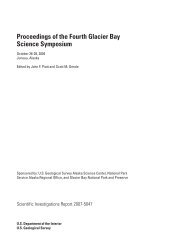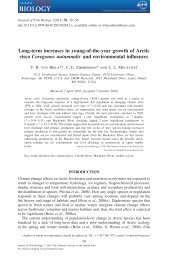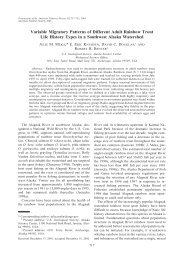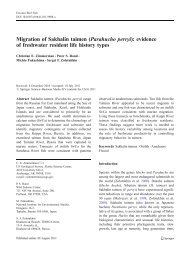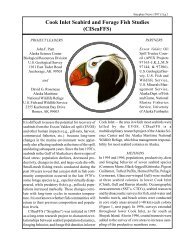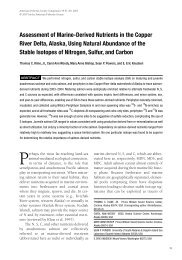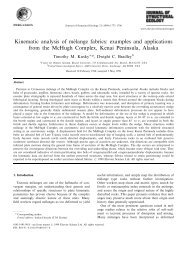Mexican native trouts: a review of their history and ... - Webspace
Mexican native trouts: a review of their history and ... - Webspace
Mexican native trouts: a review of their history and ... - Webspace
You also want an ePaper? Increase the reach of your titles
YUMPU automatically turns print PDFs into web optimized ePapers that Google loves.
300<br />
the journey leading to <strong>and</strong> beyond this point, allow us<br />
to place him unambiguously on this date in the Río<br />
Conchos basin, to the north <strong>of</strong> modern-day Nonoava,<br />
<strong>and</strong> probably in the Tecubichi, Guacareachi, or Agua<br />
Caliente sub-drainage. Furthermore, his mention <strong>of</strong><br />
groves <strong>of</strong> pine trees along the stream corroborate that<br />
he was potentially in trout habitat, probably at or<br />
above 2000 meters elevation, <strong>and</strong> argue against the<br />
possibility that his reference was to cyprinids <strong>of</strong> the<br />
genus Gila, that were sometimes called “trout” in the<br />
southwestern U.S. (Minckley, 1973), instead <strong>of</strong> to<br />
true trout. Though species <strong>of</strong> Gila in the region do<br />
range into high-elevation streams in pine forests, they<br />
are more commonly found at lower elevations (DAH<br />
unpubl.).<br />
Why have there been no subsequent collections <strong>of</strong><br />
trout from the Río Conchos? Our <strong>review</strong> <strong>of</strong> literature<br />
<strong>and</strong> museum fish collection catalogs reveal that<br />
though lower reaches <strong>of</strong> the Río Conchos basin have<br />
been moderately sampled, collections in that basin’s<br />
extensive headwater areas have been very rare since<br />
Flechsig’s <strong>and</strong> Moller’s brief excursion (above).<br />
The basin remains almost completely unsampled<br />
above 1700 m elevation, which our experience in<br />
adjacent drainages indicates to be below the lower<br />
limit for trout in the region. Sydney Anderson<br />
collected at two sites near the town <strong>of</strong> Bocoyna<br />
in 1958, taking Rio Gr<strong>and</strong>e sucker (Catostomus<br />
plebeius) <strong>and</strong> longnose dace (Rhinichthys cataractae)<br />
at about 2400 m elevation, <strong>and</strong> one <strong>of</strong> us (RLM)<br />
collected the same species from a tiny tributary <strong>of</strong><br />
the Arroyo Bocoyna in 1987. We found no scientific<br />
collections <strong>of</strong> fishes from the more than 2000 km 2 <strong>of</strong><br />
the Río Nonoava watershed, which reaches 2850 m<br />
elevation. Similarly, the Río Balleza <strong>and</strong> Río Florido<br />
are apparently unsampled for fishes above 1700 m,<br />
although they reach more than 3300 m.<br />
Did trout have access to the Río Conchos? Evidence<br />
from other fishes. Throughout the Rio Gr<strong>and</strong>e basin<br />
in the United States, presence <strong>of</strong> longnose dace is<br />
considered an indicator that trout formerly had access<br />
to, or might inhabit higher reaches <strong>of</strong>, the same<br />
streams (Mike Hatch, pers. comm., 2002; Robert<br />
Behnke, pers. comm., 2002). Our survey <strong>of</strong> museum<br />
collections found at least 14 collections from the Río<br />
Conchos basin that include longnose dace, a species<br />
also ranging to lower elevations (below typical trout<br />
habitat) in New Mexico <strong>and</strong> Texas. Longnose dace<br />
is thought to have entered the Rio Gr<strong>and</strong>e drainage<br />
via stream capture by the Pecos River between 12,000<br />
<strong>and</strong> 20,000 years ago during the last major pluvial<br />
(Hatch, 1985) <strong>and</strong> since dispersed throughout the<br />
drainage into headwaters <strong>of</strong> both the Rio Gr<strong>and</strong>e/Río<br />
Bravo <strong>and</strong> Río Conchos. The climate was much cooler<br />
during this pluvial <strong>and</strong> “life zones” for flora <strong>and</strong><br />
fauna were some 1300 meters lower than present day.<br />
Consequently, we believe the Rio Gr<strong>and</strong>e cutthroat<br />
trout could have accessed the Conchos through the<br />
same dispersal corridor. Alter<strong>native</strong>ly, trout could have<br />
arrived to the Conchos via other hydrographic connections<br />
to Pacific drainages. During mid-Pleistocene<br />
or more recently, the Río Papigochi (now the major<br />
far southeastern tributary to the upper Río Yaqui<br />
system – Figure 1) may have been confluent with<br />
the Río Conchos. Many species <strong>and</strong> groups <strong>of</strong> fishes<br />
share a Conchos – Yaqui (<strong>and</strong> beyond) distribution,<br />
<strong>and</strong> structural geology also supports the likelihood<br />
<strong>of</strong> past connections between these basins (Br<strong>and</strong>,<br />
1937; Miller, 1959; Miller, 1976; Hatch, 1985;<br />
Minckley et al., 1986; Echelle <strong>and</strong> Echelle, 1998,<br />
Minckley et al., 2002; Mayden, in press; Norris<br />
et al., in press). Among the fishes involved are<br />
species <strong>of</strong> the genus Gila (some still undescribed),<br />
the former Catostomus conchos (<strong>of</strong> the Río Conchos)<br />
that was synonymized by R.R. Miller with Catostomus<br />
bernardini <strong>of</strong> the Río Yaqui <strong>and</strong> Pacific drainages<br />
to its south (Hendrickson, 1984; Hendrickson <strong>and</strong><br />
Varela-Romero, 2002), Codoma ornata, Campostoma<br />
ornatum, <strong>and</strong> the genus Cyprinodon.<br />
Trout phylogenetic relationships <strong>and</strong> biogeography<br />
The taxonomy, systematics, <strong>and</strong> biogeography <strong>of</strong><br />
western North American trout species <strong>and</strong> subtaxa in<br />
general are relatively poorly known or in a state <strong>of</strong> flux<br />
<strong>and</strong> debate. Especially little understood are diversity<br />
<strong>and</strong> phylogenetic relationships <strong>of</strong> <strong>native</strong> <strong>Mexican</strong><br />
<strong>trouts</strong>. While many historical <strong>and</strong> recent studies <strong>of</strong><br />
variation (genetic <strong>and</strong> non-genetic data) have been<br />
conducted within <strong>and</strong> between trout species <strong>of</strong> the<br />
western United States <strong>and</strong> Canada, very few comparative<br />
analyses exist at a geographic <strong>and</strong> taxonomic<br />
scale providing meaningful genealogical information<br />
with respect to the biodiversity <strong>of</strong> these taxa <strong>and</strong><br />
the <strong>Mexican</strong> trout species <strong>and</strong> relatives. Without a<br />
doubt, most systematic <strong>and</strong> evolutionary studies <strong>of</strong><br />
western North American <strong>trouts</strong> have not been done<br />
within a comparative phylogenetic perspective <strong>and</strong><br />
have focused on single species, subspecies or populations<br />
within a species, <strong>and</strong> many <strong>of</strong> these studies have




